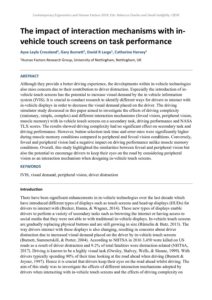| Document | Author Ayse Leyla Crossland, Gary Burnett, David R Large, Catherine Harvey |
| Abstract Although they provide a better driving experience, the developments within in-vehicle technologies also raise concern due to their contribution to driver distraction. Especially the introduction of in-vehicle touch screens has the potential to increase visual demand by the in vehicle information system (IVIS). It is crucial to conduct research to identify different ways for drivers to interact with in-vehicle displays in order to decrease the visual demand placed on the driver. The driving simulator study discussed in this paper aimed to investigate the effects of driving complexity (stationary, simple, complex) and different interaction mechanisms (foveal vision, peripheral vision, muscle memory) with in-vehicle touch screens on a secondary task, driving performance and NASA TLX scores. The results showed driving complexity had no significant effect on secondary task and driving performance. However, button selection task time and error rates were significantly higher during muscle memory conditions compared to peripheral and foveal vision conditions. Conversely, foveal and peripheral vision had a negative impact on driving performance unlike muscle memory conditions. Overall, this study highlighted the similarities between foveal and peripheral vision but also the potential to encourage drivers to keep their eyes on the road by considering peripheral vision as an interaction mechanism when designing in-vehicle touch screens. |

